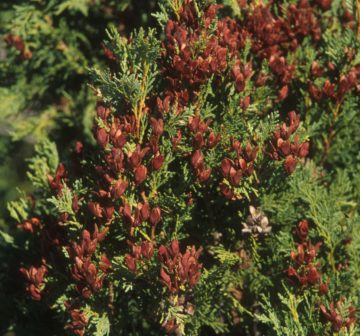Cupressaceae
Austrocedrus chilensis
A genus of a single species endemic to Argentina and Chile where it is relatively widely distribution. There has been a significant reduction in its population due to Phytophthora austrocedrae.
Human Uses
Timber was historically used for construction and making furniture. The wood is fragrant and has a durable quality suitable for outdoor use (panelling and outdoor furniture). The species is grown as an ornamental by arboreta and botanical gardens, but is not commonly seen in trade.
References and further reading
- Baccalá, N.B., Rosso, P.H. and Havrylenko, M. 1998. Austrocedrus chilensis mortality in the Nahuel Huapi National Park (Argentina). Forest Ecology and Management 109(1-2): 261-269.
- Baldini, A., Oltremari, J. and Holmgren, A. 2008. Efecto de Cinara cupressi (Hemiptera: Aphididae) sobre el ciprés de la cordillera (Austrocedrus chilensis) después de aplicar control químico. Ciencia eInvestigación Agraria 15(3): 341-350.
- Benoit, C. and Ivan, L. (eds) 1989. Libro Rojo de la Flora Terrestre de Chile. Impresora Creces Ltd, Santiago.
- Benoit, C.I. (ed.). 1989. Red Data Book on Chilean Terrestrial Flora. (Part One). pp. 91. Chilean ForestryService (CONAF), Santiago.
- Blackhall, M., Raffaelea, E. and Veblen, T.T. 2008. Cattle affect early post-fire regeneration in a Nothofagus dombeyi–Austrocedrus chilensis mixed forest in northern Patagonia, Argentina. BiologicalConservation 141: 2251-2261.
- Farjon, A. et al. 1998. Data collection forms for conifer species completed by the IUCN/SSC ConiferSpecialist Group between 1996 and 1998.
- Filip, G.P. and Rosso, P.H. 1999. Cypress mortality (mal del ciprés) in the Patagonian Andes: comparisions with similar forest diseases and declines in North America. European Journal of Forest Pathology 29(2):89-96.
- Gowda, J.H., Kitzberger, T. and Premoli, A.C. 2011. Landscape responses to a century of land use alongthe northern Patagonian forest-steppe transition. Plant Ecology 213: 259-272.
- Grill, D. and Teppner, H. 1994. Genetics of enzyme variation in Austrocedrus chilensis. Phyton 34(1): 103- 107.
- Havrylenko, M. 1989. "El mal del ciprés". Dendron 1(2).
- Havrylenko, M., Rosso, P.H. and Fontenla, S.B. 1989. Austrocedrus chilensis: contribución al estudio de sumortalidad en Argentina. Bosque 10(1): 29-36.
- Hechenleitner, P., Gardner, M., Thomas, P., Echeverría, C., Escobar, B., Brownless, P. and Martínez, C.2005. Plantas amenazadas del Centro-Sur de Chile. Distribución, Conservación y Propagación.Universidad Austral de Chile y Real Jardín Botánico de Edimburgo, Santiago.
- Hennon P.E. and Rajchenberg, M. 2000. El mal del Ciprés. Algunas observaciones, comparaciones eideas. Patagonia Forestal 6(2): 4–6.
- Hranilovich, S. 1988. Informe histórico sobre el 'Mal del Ciprés' de la Cordillera (Austrocedrus chilensis).Revista de la Asociación Forestal Argentina Año XLII(3): 58-62.
- Mermoz, M., Kitzberger, T. and Veblen, T. 2005. Landscape Influences on occurrence and spread ofwildfires in Patagonian forests and shrublands. Ecology 86(10): 2705-2715.
- Orellana, I.A. and Raffaele, E. 2010. The spread of the exotic conifer Pseudotsuga menziesii inAustrocedrus chilensis forests and shrublands in northwestern Patagonia, Argentina. New ZealandJournal of Forestry Science 40: 199-209.
- Pena, M.A. and Altmann, S.A. 2009. Use of satellite-derived hyperspectral indices to identify stresssymptoms in an Austrocedrus chilensis forest infested by the aphid Cinara cupressi. International Journalof Pest Management 55(3): 197-206.
- Relva, M.A. and Veblen, T.T. 1998. Impacts of large herbivores on Austrocedrus chilensis forests inPatagonia, Argentina. Forest Ecology and Management 108: 27-40.
- Rovere, A. 2000. Condiciones ambientales de la regeneración del ciprés de la cordillera (Austrocedruschilensis). Bosque 21: 57-64.
- Rusch V. et al. 2002. Biodiversity Conservation in Austrocedrus chilensis (Cordillera cypress) forests. Final Project Report. FVSA, Turner Report.
- Sarasola M.A., Rusch V.E., Schlichter T.A. and Hersa, C.M.G. 2006. Invasión de coníferas forestales enáreas de estepa y bosques de ciprés de la cordillera en la Región Andino Patagónica. Ecología Austral16(2): 143-156.
- Schlegel, F. 1962. Hallazgo de un bosque de cipreses cordilleranos en la Provincia de Aconcagua. BoletinUniversidad de Chile 32: 43-46.
- Seibert, P. 1982. Carta de vegetación de la región de El Bolsón, Rio Negro y su aplicación a la planificación de uso de la tierra. Documenta Phytosociologica 2: 1-120.
- Souto, C. & Gardner, M. 2013. Austrocedrus chilensis. The IUCN Red List of Threatened Species 2013: e.T31359A2805519. http://dx.doi.org/10.2305/IUCN.UK.2013-1.RLTS.T31359A2805519.en. Downloaded on 04 August 2017
- Souto, C.P., Heinemann, K., Kitzberger, T. and Premoli, A.C. 2011. Species diversity in north-westernPatagonian dryland forests: implications for restoration in Impact of forest fragmentation anddegradation on patterns of genetic variation and its implication for forest restoration. In: A. Newtonand N. Tejedo (eds), Principles and Practice of Forest Landscape Restoration, IUCN, Gland, Switzerland.
- Souto, C.P., Heinemann, K., Kitzberger, T., Newton, A.C. and Premoli, A.C. 2012. Genetic diversity andstructure in Austrocedrus chilensis populations: implications for dryland forest restoration. RestorationEcology 20(5): 568-575.
- Veblen, T.T. and Lorenz, D. 1987. Postfire stand development of Austrocedrus-Nothofagus forests innorthern Patagonia. Vegetatio 71: 113-126.
- Veblen,T.T., Burns, B.R., Kitzberger, T., Lara, A. and Villalba, R. 1995. The ecology of the conifers ofsouthern South America. In: N.J. Enright and R.S. Hills (eds), Ecology of the Southern Conifers, pp. 142-148. Melbourne University Press, Victoria.







